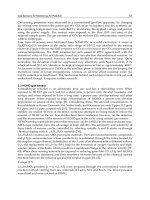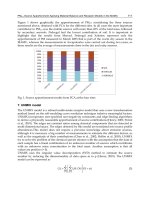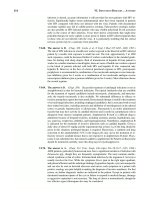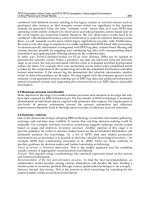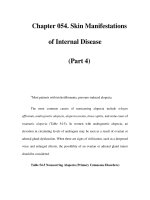Chapter 127. Treatment and Prophylaxis of Bacterial Infections (Part 4) pdf
Bạn đang xem bản rút gọn của tài liệu. Xem và tải ngay bản đầy đủ của tài liệu tại đây (78.95 KB, 7 trang )
Chapter 127. Treatment and Prophylaxis
of Bacterial Infections
(Part 4)
Trimethoprim
Trimethoprim is a diaminopyrimidine, a structural analogue of the pteridine
moiety of folic acid. Trimethoprim is a competitive inhibitor of dihydrofolate
reductase; this enzyme is responsible for reduction of dihydrofolic acid to
tetrahydrofolic acid—the essential final component in the folic acid synthesis
pathway. Like that of the sulfonamides, the activity of trimethoprim is
compromised in the presence of exogenous thymine or thymidine.
Inhibition of Nucleic Acid Synthesis or Activity
Numerous antibacterial compounds have disparate effects on nucleic acids.
Quinolones
The quinolones, including nalidixic acid and its fluorinated derivatives
(ciprofloxacin, levofloxacin, and moxifloxacin), are synthetic compounds that
inhibit the activity of the A subunit of the bacterial enzyme DNA gyrase as well as
topoisomerase IV. DNA gyrase and topoisomerases are responsible for negative
supercoiling of DNA—an essential conformation for DNA replication in the intact
cell. Inhibition of the activity of DNA gyrase and topoisomerase IV is lethal to
bacterial cells. The antibiotic novobiocin also interferes with the activity of DNA
gyrase, but it interferes with the B subunit.
Rifampin
Rifampin, used primarily against Mycobacterium tuberculosis , is also
active against a variety of other bacteria. Rifampin binds tightly to the B subunit
of bacterial DNA-dependent RNA polymerase, thus inhibiting transcription of
DNA into RNA. Mammalian-cell RNA polymerase is not sensitive to this
compound.
Nitrofurantoin
Nitrofurantoin, a synthetic compound, causes DNA damage. The
nitrofurans, compounds containing a single five-membered ring, are reduced by a
bacterial enzyme to highly reactive, short-lived intermediates that are thought to
cause DNA strand breakage, either directly or indirectly.
Metronidazole
Metronidazole, a synthetic imidazole, is active only against anaerobic
bacteria and protozoa. The reduction of metronidazole's nitro group by the
bacterial anaerobic electron-transport system produces a transient series of
reactive intermediates that are thought to cause DNA damage.
Alteration of Cell-Membrane Permeability
Polymyxins
The polymyxins [polymyxin B and colistin (polymyxin E)] are cyclic, basic
polypeptides. They behave as cationic, surface-active compounds that disrupt the
permeability of both the outer and the cytoplasmic membranes of gram-negative
bacteria.
Gramicidin a
Gramicidin A is a polypeptide of 15 amino acids that acts as an ionophore,
forming pores or channels in lipid bilayers.
Daptomycin
Insertion of daptomycin, a new bactericidal lipopeptide antibiotic, into the
cell membrane of gram-positive bacteria forms a channel that causes
depolarization of the membrane by efflux of intracellular ions, resulting in cell
death.
Mechanisms of Resistance
Some bacteria exhibit intrinsic resistance to certain classes of antibacterial
agents (e.g., obligate anaerobic bacteria to aminoglycosides and gram-negative
bacteria to vancomycin). In addition, bacteria that are ordinarily susceptible to
antibacterial agents can acquire resistance. Acquired resistance is a major
limitation to effective antibacterial chemotherapy. Resistance can develop by
mutation of resident genes or by acquisition of new genes. New genes mediating
resistance are usually spread from cell to cell by way of mobile genetic elements
such as plasmids, transposons, and bacteriophages. The resistant bacterial
populations flourish in areas of high antimicrobial use, where they enjoy a
selective advantage over susceptible populations.
The major mechanisms used by bacteria to resist the action of antimicrobial
agents are inactivation of the compound, alteration or overproduction of the
antibacterial target through mutation of the target protein's gene, acquisition of a
new gene that encodes a drug-insensitive target, decreased permeability of the cell
envelope to the agent, failure to convert an inactive prodrug to its active
derivative, and active efflux of the compound from the periplasm or interior of the
cell. Specific mechanisms of bacterial resistance to the major antibacterial agents
are outlined below, summarized in Table 127-1, and depicted in Fig. 127-1.
β-Lactam Antibiotics
Bacteria develop resistance to β-lactam antibiotics by a variety of
mechanisms. Most common is the destruction of the drug by β-lactamases. The β-
lactamases of gram-negative bacteria are confined to the periplasm, between the
inner and outer membranes, while gram-positive bacteria secrete their β-
lactamases into the surrounding medium. These enzymes have a higher affinity for
the antibiotic than the antibiotic has for its target. Binding results in hydrolysis of
the β-lactam ring. Genes encoding β-lactamases have been found in both
chromosomal and extrachromosomal locations and in both gram-positive and
gram-negative bacteria; these genes are often on mobile genetic elements. Many
"advanced-generation" β-lactam antibiotics, such as ceftriaxone and cefepime, are
stable in the presence of plasmid-mediated β-lactamases and are active against
bacteria resistant to earlier-generation β-lactam antibiotics. However, extended-
spectrum β-lactamases (ESBLs), either acquired on mobile genetic elements by
gram-negative bacteria (e.g., Klebsiella pneumoniae and Escherichia coli) or
present as stable chromosomal genes in other gram-negative species (e.g.,
Enterobacter spp.), have broad substrate specificity, hydrolyzing virtually all
penicillins and cephalosporins. One strategy that has been devised for
circumventing resistance mediated by β-lactamases is to combine the β-lactam
agent with an inhibitor that avidly binds the inactivating enzyme, preventing its
attack on the antibiotic. Unfortunately, the inhibitors (e.g., clavulanic acid,
sulbactam, and tazobactam) do not bind all chromosomal β-lactamases (e.g., that
of Enterobacter) and thus cannot be depended on to prevent the inactivation of β-
lactam antibiotics by such enzymes. No β-lactam antibiotic or inhibitor has been
produced that can resist all of the many β-lactamases that have been identified.
A second mechanism of bacterial resistance to β-lactam antibiotics is an
alteration in PBP targets so that the PBPs have a markedly reduced affinity for the
drug. While this alteration may occur by mutation of existing genes, the
acquisition of new PBP genes (as in staphylococcal resistance to methicillin) or of
new pieces of PBP genes (as in streptococcal, gonococcal, and meningococcal
resistance to penicillin) is more important.
A final resistance mechanism is the coupling, in gram-negative bacteria, of
a decrease in outer-membrane permeability with rapid efflux of the antibiotic from
the periplasm to the cell exterior. Mutations of genes encoding outer-membrane
protein channels called porins decrease the entry of β-lactam antibiotics into the
cell, while additional proteins form channels that actively pump β-lactams out of
the cell. Resistance of Enterobacteriaceae to some cephalosporins and resistance
of Pseudomonas spp. to cephalosporins and piperacillin are the best examples of
this mechanism.
